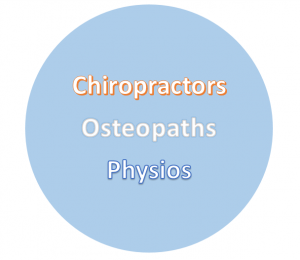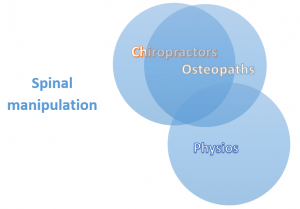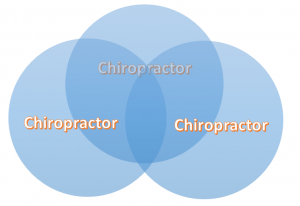What is the difference between Chiropractors, Osteopaths and Physiotherapists?

Posted 11.01.2019
This is a question that has come up many times and will continue to do so! So what do we need to know about the difference between Chiropractor’s, Osteopaths and Physios? Let’s ask some questions to see if that helps point us in the right direction.
Will their definitions help clear things up?
These definitions are taken from the regulatory bodies or societies of the three respective professions:
One is ‘a system of diagnosis and treatment for a wide range of medical conditions. It works with the structure and function of the body, and is based on the principle that the well-being of an individual depends on the skeleton, muscles, ligaments and connective tissues functioning smoothly together.’1
One is ‘a science-based profession and takes a ‘whole person’ approach to health and well being, which includes the patient’s general lifestyle. At the core is the patient’s involvement in their own care, through education, awareness, empowerment and participation in their treatment.’2
And another is ‘A health profession concerned with the diagnosis, treatment and prevention of mechanical disorders of the musculoskeletal system, and the effects of these disorders on the function of the nervous system and general health. There is an emphasis on manual treatments including spinal adjustment and other joint and soft-tissue manipulation.’3
Does that make it clearer for you?! I believe you would certainly have to have a good background knowledge base in at least 2 of the professions to figure out which definition belongs to which profession (see the answers at the end). How about if we ask…
Do they treat back pain?

Yes, you can see any of the above as they are all qualified to treat back pain (just always remember to make sure they actually hold the correct qualifications and are professionally registered – or see our guide to choosing the right clinic for your problem here).
In general a physiotherapy course covers a wider array of specialist areas relating to rehabilitation (respiratory, post surgical, post stroke etc) and does not just focus on musculoskeletal problems as the only teaching unit – so typically a Physiotherapist will choose to do extra courses to specialise in musculoskeletal problems such as back pain prior to opening up a private clinic, and if you are being referred by your GP they will refer you to the correct department. There is also a heavy emphasis and need for Physios within sports teams.
Chiropractors and Osteopaths primarily focus on musculoskeletal problems from day one, very intensely, in their teaching approach. Chiropractors are not placed in hospitals to provide rehabilitation so they spend every aspect of training specifically towards the end goal of being leaders in musculoskeletal issues specifically relating to disorders of the spine. I personally went to our ‘8am club’ most days where we would meet before class to practice spinal manipulations EVERY WEEKDAY in addition to our full schedule.
But that still doesn’t separate the professions hugely.
So is spinal manipulation the main difference?
If we had to sum it up in one sentence then this would probably be the main difference. Chiropractors and Osteopaths manipulate the spine very frequently and it is their area of speciality (as I said above we practised an extra hour a day just on this technique for 4 years!) whereas Physiotherapists tend to opt more to joint mobilisations rather than manipulations.

We can see that there will be overlapping areas in terms of the similarities in terms of the treatment techniques, or advice that the professionals will give you. The above diagram isn’t to scale or weighted in any way. If we are saying it is manipulation that is the difference it would probably look like this:

And then if this was a blog post for Chiropractors, Osteopaths and Physiotherapists it would probably spark an argument between them wondering why Physios call it ‘manips’ and why some Chiropractors are so passionate about the fact that ‘we don’t manipulate anything, we specifically adjust the spinal segment’!
So are there differences within professions?
Certainly. Each University course will teach their students to the same level – however as a professional once qualified you have the freedom to choose any specific techniques or approaches which you feel work best a) for you and therefore b) for your patients. Someone might be really good and enthusiastic about myofascial release techniques (a specific technique to release muscular tension) so they go on lots of courses and use it a lot in practice, getting better at it along the way.
A Chiropractor may wish to use more diversified techniques (hands on spinal manipulations or adjustments!) or they may chose not to do any manipulations and use very gentle techniques such as SOT (Sacro-occipital technique) or use the Activator protocol. As such you can sometimes have 3 Chiropractors, each with a different approach in their speciality.

Personally I think that the human body is so complex, and the professions use so many different ways of getting people better that it just gets a bit diluted when we say ‘physios just give exercises and Chiropractors just crack bones’.
All we can do as professionals is do what we do best to get patients better. Chiropractors certainly spend so much time practising and devoting their career to spinal manipulation and adjustments with differing forces to correct spinal and joint problems. I believe it is this dedication to mastering spinal manipulations and assessing the whole body that has certainly given me an edge as a Chiropractor.
Our approach?
At Duffield Chiropractic Clinic we assess people as a whole checking the spine, extremity joints, muscles and nervous system. We have a systematic approach checking for level of strength, symmetry and stiffness in your body to find out what caused the problem. After all that, it is whatever treatment that will work best for you that we will offer first – if it is a manipulation or a muscle release, or something completely different.
If you want to see our guide for choosing the right professional for you problem please read it here, or otherwise if you need to see us please call or book in to see us at the clinic here.
Andrew Harlow – Derby Chiropractor
References / Answers!
- osteopathy.org.uk
- csp.org.uk (chartered society of physiotherapists)
- wfc.org (World Federation of Chiropractic 2001)
Other posts
Andrew made me feel comfortable immediately, listening carefully and giving me time to explain my concerns. He asked questions to elicit the exact nature of my problems and after treatment gave me advice on how to avoid problems in the future, His understanding, patience, and holistic approach has ensured I got better after treatment and also am able to keep active and fit. - Kate Tollervey
I have seen a lot of people over the years and like Andrew’s approach as he is extremely logical and always finds the root cause of the problem. Very happy to be back on the golf course. - Sam Warrington
Andrew dealt with me in a professional manor and was incredibly knowledgeable and thorough in his treatment. Highly recommended. Thank you very much. - Christine Charles
I have been treated by him over the last 6 years and have always been very impressed. - Robert Cooper
